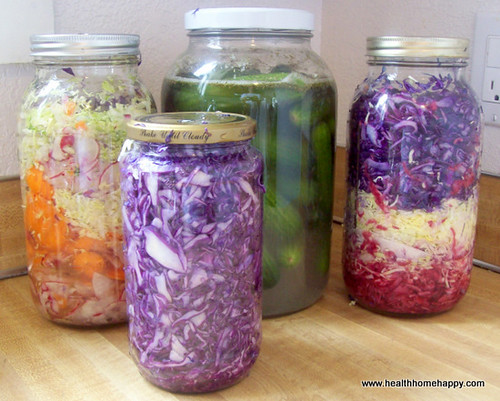First, two articles:
Avoid These 5 GAPS Diet Mistakes
Summary: Too Many PUFAs and Meat, Not Enough Prebiotics, Carbs, and food in general.
The Five Most Common GAPS Diet Mistakes
Summary: Keeping Starches, Taking a Cheaper Probiotic or No Probiotic at All, Not Making/Eating Enough Homemade Broth, Giving Up Too Soo
Here is the GAPS diet in a nutshell.
 |
| Thank you for lots of tips, healthhomehappy.com! :) |
You proceed through the stages as you accomplish health steps, which are described somewhere and I need to find.
GAPS Diet Intro Stages
You can eat on stage 1:
• Meat or fish stock
• Well boiled broccoli, cauliflower, carrots, onions, leeks
• Squash, winter and summer
• Boiled meat
• Sea salt,
• 1-2 teaspoons a day of sauerkraut juice
Read here on handling stage 1.
Stage 2
You can eat on Stage 2:
• Meat or fish stock
• Well boiled GAPS-legal vegetables (no starchy root vegetables)
• Squash, winter and summer
• Boiled meat
• Sea salt
• Fresh herbs
• Fermented vegetables; sauerkraut, kimchi, pickles
• Fermented fish
• Egg yolk, organic, carefully separated from the white
• Homemade ghee
• Stews and casseroles made with meat and vegetables
Stage 3
You can eat on Stage 3:
• Meat or fish stock
• Well boiled GAPS-legal vegetables (no starchy root vegetables)
• Squash, winter and summer
• Boiled meat
• Sea salt
• Fresh herbs
• Fermented vegetables; saurkraut, kimchi, pickles
• Fermented fish
• Egg yolk, organic, carefully separated from the white
• Homemade ghee
• Stews and casseroles made with meat and vegetables
• Ripe avocado mashed into soups, starting with 1-3 teaspoons a day
• Pancakes made with nutbutter, squash, and eggs- fried in fat or ghee, start with one a day
• Scrambled eggs made with ghee and served with avocado if tolerated and cooked vegetables.
Stage 4
You can eat on Stage 4:
• Meat or fish stock
• Well boiled GAPS-legal vegetables (no starchy root vegetables)
• Squash, winter and summer
• Boiled, roasted, or grilled meat (not burned)
• Sea salt
• Fresh herbs
• Cold pressed olive oil
• Fermented vegetables; saurkraut, kimchi, pickles
• Fermented fish
• Egg yolk, organic, carefully separated from the white
• Homemade ghee
• Stews and casseroles made with meat and vegetables
• Ripe avocado mashed into soups, starting with 1-3 teaspoons a day
• Pancakes made with nutbutter, squash, and eggs- fried in fat or ghee, start with one a day
• Scrambled eggs made with ghee and served with avocado if tolerated and cooked vegetables.
• Freshly pressed juices, start with a few tablespoons of carrot juice
• Bread made with nut flour, eggs, squash, tolerated fat, salt
You can eat on Stage 5:
• Meat or fish stock
• Raw legal vegetables, peeled
• Squash, winter and summer
• Peeled, cooked apple, pureed
• Honey, up to a couple tablespoons a day
• Boiled, roasted, or grilled meat (not burned)
• Sea salt
• Fresh herbs
• Cold pressed olive oil
• Fermented vegetables; saurkraut, kimchi, pickles
• Fermented fish
• Egg yolk, organic, carefully separated from the white
• Homemade ghee
• Stews and casseroles made with meat and vegetables
• Ripe avocado mashed into soups, starting with 1-3 teaspoons a day
• Pancakes made with nutbutter, squash, and eggs- fried in fat or ghee, start with one a day
• Scrambled eggs made with ghee and served with avocado if tolerated and cooked vegetables.
• Freshly pressed juices, carrot, mint, cabbage, lettuce, apple, pineapple, mango
• Bread made with nut flour, eggs, squash, tolerated fat, salt
Stage 6
You can eat on Stage 6:
• Meat or fish stock
• Raw legal vegetables, peeled
• Squash, winter and summer
• Peeled, raw apple
• Other fruits, raw, introduce slowly
• Honey, up to a couple tablespoons a day
• Boiled, roasted, or grilled meat (not burned)
• Sea salt
• Fresh herbs
• Cold pressed olive oil
• Fermented vegetables; saurkraut, kimchi, pickles
• Fermented fish
• Egg yolk, organic, carefully separated from the white
• Homemade ghee
• Stews and casseroles made with meat and vegetables
• Ripe avocado mashed into soups, starting with 1-3 teaspoons a day
• Pancakes made with nutbutter, squash, and eggs- fried in fat or ghee, start with one a day
• Scrambled eggs made with ghee and served with avocado if tolerated and cooked vegetables.
• Freshly pressed juices, carrot, mint, cabbage, lettuce, apple, pineapple, mango
• Bread made with nut flour, eggs, squash, tolerated fat, salt- use dates and dried fruit to sweeten.
Allowed Foods for Full GAPS diet
--------------------
GAPS Supplementation Protocol
As suggested in the book Gut & Psychology Syndrome by Dr. Natasha Campbell-McBride
The following supplementation protocol should be taken in conjunction with the GAPS diet. For detailed information on this protocol, please refer to the book Gut & Psychology Syndrome by Dr. Natasha Campbell-McBride.
The essential supplements for GAPS patients(entire description in this document): (For more information on GAPS go to www.GAPSdiet.com)
1.An effective therapeutic strength probiotic.
2.Essential fatty acids.
3.Vitamin A.
4.Digestive enzymes.
5.Vitamin and mineral supplements.
Implementing: How do you actually do it?
Previous posts dealt with some tips and prep. Preparation is key.
Budget-wise....
Dr. Natasha recommends as much organic as possible, but when you have to choose between organic produce (esp. the clean 15) and organic animal products, she says go with the produce because animals have defenses against chemicals, while plants do not.
I mean, sick, contaminating fish will die before they can be killed and eaten. And oranges can't bite the hand that paints them.
No comments:
Post a Comment
Thanks so much! I greatly value thoughtful comments!! ~ Gabriela